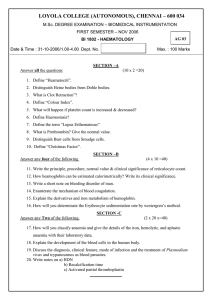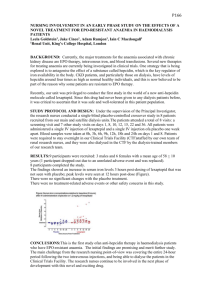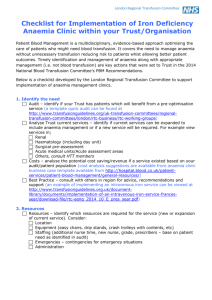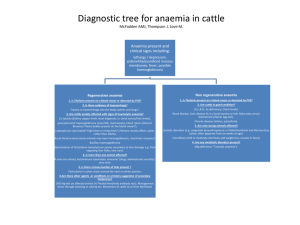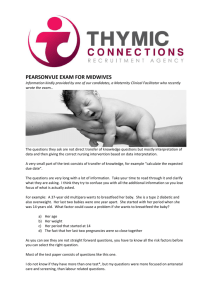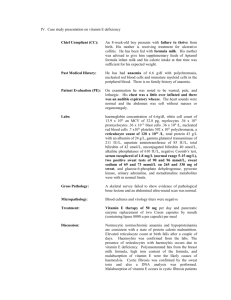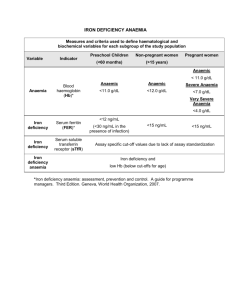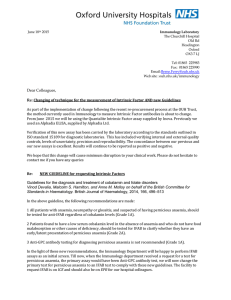Complete Blood Count (CBC) in Primary Care: Interpretation
advertisement
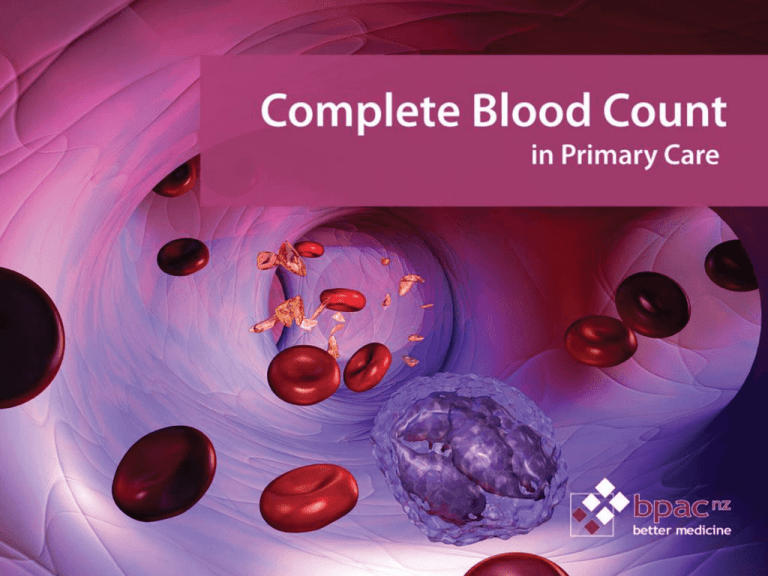
Complete blood count in primary care Key points/purpose Provide an overview of the use of the complete blood count in primary care Provide advice on appropriate follow-up for abnormal results This is a consensus document This is a consensus document produced in conjunction with specialist haematologists, providing an overview for some scenarios encountered in primary care. Haematopoiesis (Cell development) Limitations of reference ranges Many factors that may affect CBC parameters: – iron deficiency – thalassaemia – medication – alcohol – minor infections – ethnic differences – gender – pregnancy Interpret results in clinical context • All haematology results need to be interpreted in the context of a thorough history and physical examination, as well as previous results. History and clinical examination Important features of history and clinical examination: – pallor, jaundice – fever, lymphadenopathy – bleeding/bruising – hepatomegaly, splenomegaly – frequency and severity of infections, mouth ulcers, recent viral illness – exposure to drugs and toxins – fatigue/weight loss Total WBC may be misleading The absolute count of each of the cell types is more useful than the total. The total count may be misleading, eg: low neutrophils with an elevated lymphocyte count may produce a total white count that falls within the reference range. Neutrophils – Low Significant levels < 0.5 x 109/L (high risk infection) Most common causes – viral (overt or occult) – autoimmune/idiopathic – drugs Red flags – person particularly unwell – severity – rate of change of neutropenia – lymphadenopathy, hepatosplenomegaly Neutrophils – High Most common causes – infection/inflammation – Necrosis/malignancy – any stressor/heavy exercise – drugs – pregnancy – CML Red flags – person particularly unwell – severity – rate of change of neutrophilia – presence of left shift Lymphocytes Lymphocyte – Low – not usually clinically significant Lymphocyte – High – isolated elevated count not usually significant Causes • acute infection (viral, bacterial) • smoking • hyposplenism • acute stress response • autoimmune thyroiditis • CLL Monocytes Monocytes – Low – not clinically significant Monocytes – High – usually not significant – watch levels > 1.5 x109/L more closely Eosinophils Eosinophils – Low – no real cause for concern Eosinophils – High Most common causes: – allergy/atopy: asthma/hayfever – parasites (less common in developed countries) Rarer causes: – Hodgkins – myeloproliferative disorders – Churg-Strauss syndrome Basophils Basophils – Low – difficult to demonstrate Basophils – High Associated with – myeloproliferative disorders – other rare causes Platelets – Low Significant levels < 100 x109/L Most common causes – viral infection – idiopathic thrombocytopenic purpura – liver disease – drugs – hypersplenism – autoimmune disease – pregnancy Red flags – bruising – petechiae – signs of bleeding Platelets – High Significant levels > 500 x109/L Most likely causes – reactive conditions eg infection, inflammation – pregnancy – iron deficiency – post splenectomy – essential thrombocythaemia Low haemoglobin Useful to use MCV to classify the anaemia – Microcytic, MCV < 80 fl – Normocytic, MCV 80 – 100 fl – Macrocytic, MCV > 100 fl Microcytic Anaemia The three most common causes for microcytic anaemia are: – Iron deficiency – Thalassaemia – Anaemia of Chronic disease Normocytic anaemia The causes of normocytic anaemia include: – Bleeding – Early nutritional anaemia (iron, B12, folate deficiencies) – Anaemia of renal insufficiency – Anaemia of chronic disease/chronic inflammation – Haemolysis – Primary bone marrow disorder Macrocytic anaemia Common causes: – Alcohol – Liver disease – B12 or folate deficiency – Thyroid disease – Some drugs (especially hydroxyurea) High haemoglobin Hb often accompanied by PCV Can reflect decreased plasma volume (eg: dehydration, alcohol, cigarette smoking, diuretics) or Increased red cell mass (eg polycythaemia)
